Central Nervous System

-consists of the brain and spinal cord, which primarily interpret incoming sensory information and issue instructions based on that info and on past experience
Peripheral Nervous System

-consists of the cranial and spinal nerves, ganglia, and sensory receptors
Two Subdivisions of PNS
1.Sensory Portion
2.Motor Portion
Sensory Portion
-consists of nerve fibers that conduct impulses toward the CNS
Motor Portion
-contains nerve fibers that conduct impulses away from the CNS
-consists of the somatic division and autonomic nervous system
Somatic Division (sometimes called the voluntary system)

-controls the skeletal muscles
Autonomic Nervous System (often referred to as Involuntary Nervous System)

-controls smooth and cardiac muscles and glands
- its sympathetic and parasympathetic branches play a role in maintaining homeostasis
Neural Tube
-epithelial tube developed from the neural plate and forming the central nervous system of the embyro
Three major regions of the brain

1.Forebrain
2.Midbrain
3.Hindbrain
Ventricles

-cavities within the brain that are filled with cerebrospinal fluid
Cerebral Hemispheres

-either half of the cerebrum
the most superior portion of the brain
Gyri

-elevated ridges of tissue
Sulci

-shallow grooves
Fissures

-deeper grooves
Longitudinal Fissure

-single deep fissure
Central Sulcus

-divides the frontal lobe from the parietal lobe
Lateral Sulcus

-separates the temporal lobe from the parietal lobe
Parieto-occipital Sulcus

-on the medial surface of each hemisphere divides the occipital lobe from the parietal lobe
Insula
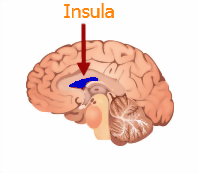
-fifth lobe of each cerebral hemispheres
-buried deep within the lateral sulcus
-covered by portions of the temporal, parietal, and frontal lobes.
Primary Somatosensory Cortex

-region of the brain where nerve signals from the sense of touch are normally received
-located in the postcentral gyrus of the parietal lobe
Somatosensory Association Cortex
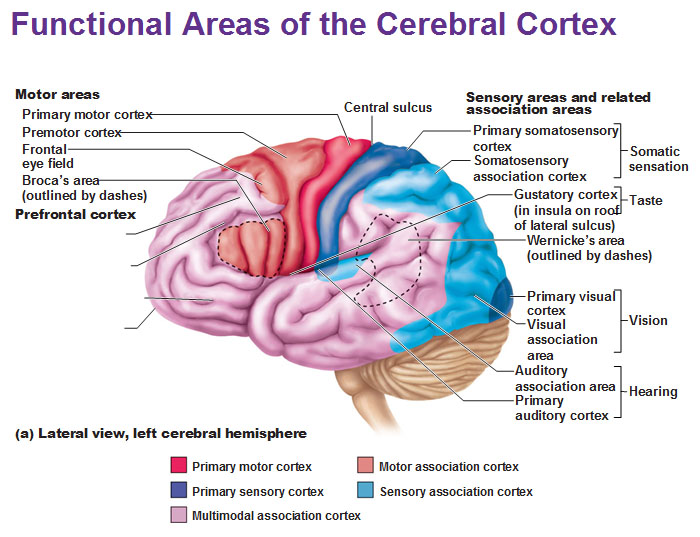
-incoming stimuli is analyzed
-allows you to become aware of pain, coldness, a light touch, and the like
Uncus
- the hooklike anterior end of the hippocampal gyrus on the temporal lobe of the brain
Primary Motor Cortex

- responsible for conscious or voluntary movement of skeletal muscles.
-located in the precentral gyrus of the frontal lobe
Broca's area

-specialized speech motor area
-located at the base of the precentral gyrus just above the lateral sulcus
-located in only one cerebral hemisphere, usually the left
Prefrontal Cortex
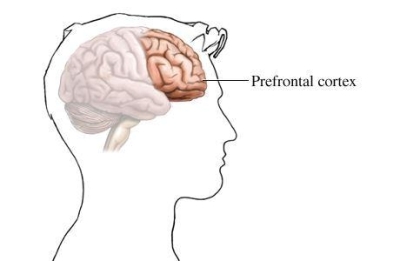
-contains many areas involved in intellect, complex reasoning, and personality
-anterior portions of the frontal lobes
Wernicke's Area

-at the junction of the parietal and temporal lobes
-an area in which familiar words are sounded out
-located in only one cerebral hemisphere, typically left
Cerebral Cortex

-outer layer of gray matter of the cerebral hemispheres
-responsible for for higher brain function, including sensation, voluntary muscle movement, thought, reasoning, and memory
Cerebral White Matter
-composed of fiber tracts carrying impulses to or from the cortex
Diencephalon

-posterior part of the forebrain that connects the midbrain with the cerebral hemispheres
-encloses the third ventricle, and contains the thalamus and hypothalmus
Olfactory Bulbs

-the bulblike distal end of the olfactory lobe, where the olfactory nerves begin
-synapse point of cranial nerve I
Pituitary Gland

-small oval endocrine gland attached to the base of the vertebrate brain and consisting of an anterior and posterior lobe
Mammillary Bodies

- one of two small round structures on the undersurface of the brain that form the terminals of the anterior arches of the fornix
-relay stations for olfaction
-bulges exteriorly from the floor of the hypothalamus just posterior to the pituitary gland
Brain Stem
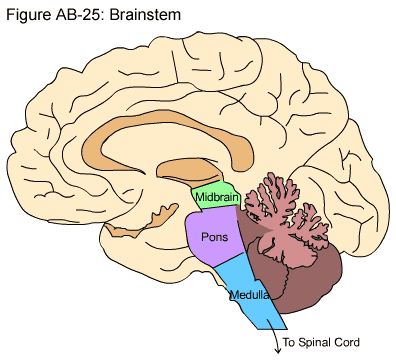
-the stemlike portion of the brain connecting the cerebral hemispheres with the spinal cord
-comprising the pons, medulla oblongata, and midbrain
Cerebellum

-cauliflower-like
-projects dorsally from under the occipital lobes of the cerebrum.
*outer cortex made up of gray matter
*inner region of white matter
Pons

-consists primarily of motor and sensory fiber tracts connecting the brain with lower CNS centers
Medulla Oblongata

composed primarily of fiber tracts
Corpus Callosum

-major commissure connecting the cerebral hemispheres
Fornix

-bandlike fiber tract concerned with olfaction as well as limbic system functions
Septum Pellucidum

-separates the lateral ventricles of the cerebral hemispheres
Thalamus
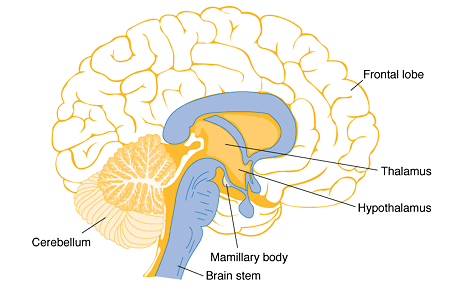
-consists of two large lobes of gray matter that laterally enclose the shallow third ventricle of the brain
Hypothalamus

-makes up the floor and inferolateral walls of the third ventricle
-involved in regulation of body temperature, water balance, and fat and carbohydrate metabolism
Epithalamus
-forms the roof of the third ventricle
-most dorsal portion of the diencephalon
-contains pineal gland
Cerebral Aqueduct

-a slender canal traveling through the midbrain
-connects the third ventricle to the fourth ventricle in the hindbrain below
Meninges

-3 layer of connective tissue membranes covering and protecting the brain and spinal cord
Dura Mater

-outermost meninx double layered membrane
1.Periosteal layer
- attached to the inner surface of the skull forming the periosteum
2.Meningeal Layer
- forms the outermost brain covering and it continuous with the dura mater of the spinal cord
Arachnoid Mater

-weblike middle meninx
-underlies the dura mater and is partially separated from it by the subdural space
Pia Mater

-the innermost meninx
-highly vascular and clings tenaciously to the surface of the brain